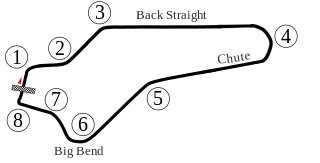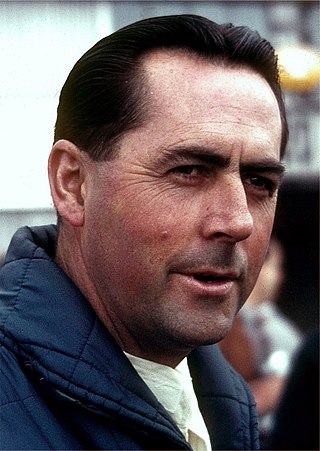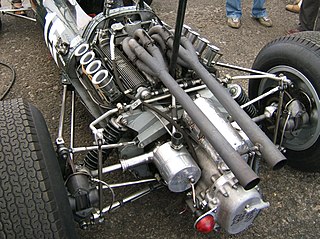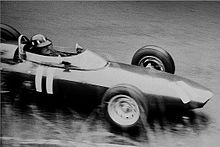
British Racing Motors (BRM) was a British Formula One motor racing team. Founded in 1945 and based in the market town of Bourne in Lincolnshire, it participated from 1951 to 1977, competing in 197 grands prix and winning seventeen. BRM won the constructors' title in 1962 when its driver Graham Hill became world champion. In 1963, 1964, 1965 and 1971, BRM came second in the constructors' competition.

The 1962 United States Grand Prix was a Formula One motor race held on October 7, 1962, at the Watkins Glen Grand Prix Race Course in Watkins Glen, New York. It was race 8 of 9 in both the 1962 World Championship of Drivers and the 1962 International Cup for Formula One Manufacturers. The 100-lap race was won by Lotus driver Jim Clark after starting from pole position. Graham Hill finished second for the BRM team and Cooper driver Bruce McLaren came in third.

The 1963 United States Grand Prix was a Formula One motor race held on October 6, 1963, at the Watkins Glen Grand Prix Race Course in Watkins Glen, New York. It was race 8 of 10 in both the 1963 World Championship of Drivers and the 1963 International Cup for Formula One Manufacturers. The 110-lap race was won by BRM driver Graham Hill after he started from pole position. His teammate Richie Ginther finished second and Lotus driver Jim Clark came in third.

The 1964 United States Grand Prix was a Formula One motor race held on October 4, 1964, at the Watkins Glen Grand Prix Race Course in Watkins Glen, New York. It was race 9 of 10 in both the 1964 World Championship of Drivers and the 1964 International Cup for Formula One Manufacturers. The 110-lap race was won by BRM driver Graham Hill after he started from fourth position. John Surtees finished second for the Ferrari team and Brabham driver Jo Siffert came in third.

The 1964 Mexican Grand Prix was a Formula One motor race held at the Ciudad Deportiva Magdalena Mixhuca in Mexico City on 25 October 1964. It was race 10 of 10 in both the 1964 World Championship of Drivers and the 1964 International Cup for Formula One Manufacturers.

The 1966 Formula One season was the 20th season of FIA Formula One motor racing. It featured the 17th World Championship of Drivers, the 9th International Cup for F1 Manufacturers, and four non-championship races open to Formula One cars. The World Championship was contested over nine races between 22 May and 23 October 1966.

The 1965 Formula One season was the 19th season of FIA Formula One racing. It featured the 16th World Championship of Drivers, the 8th International Cup for F1 Manufacturers, and seven non-championship races open to Formula One cars. The World Championship was contested over ten races between 1 January and 24 October 1965.

The 1964 Formula One season was the 18th season of FIA Formula One motor racing. It featured the 15th World Championship of Drivers, the 7th International Cup for F1 Manufacturers, and eight non-championship races open to Formula One cars. The World Championship was contested over ten races between 10 May and 25 October 1964.

The 1963 Formula One season was the 17th season of FIA Formula One motor racing. It featured the 14th World Championship of Drivers, the 6th International Cup for F1 Manufacturers, and numerous non-championship Formula One races. The World Championship was contested over ten races between 26 May and 28 December 1963.

The 1962 Formula One season was the 16th season of FIA Formula One motor racing. It featured the 13th World Championship of Drivers, the 5th International Cup for F1 Manufacturers, and numerous non-championship Formula One races. The World Championship was contested over nine races between 20 May and 29 December 1962.

The 1961 Formula One season was the 15th season of FIA Formula One motor racing. It featured the 12th World Championship of Drivers, the 4th International Cup for F1 Manufacturers, and numerous non-championship Formula One races. The World Championship was contested over eight races between 14 May and 8 October 1961.

The 1960 Formula One season was the 14th season of FIA Formula One motor racing. It featured the 11th World Championship of Drivers, the third International Cup for F1 Manufacturers and five non-championship Formula One races. The World Championship was contested over ten races between 7 February and 20 November 1960.

The Brabham BT19 is a Formula One racing car designed by Ron Tauranac for the British Brabham team. The BT19 competed in the 1966 and 1967 Formula One World Championships and was used by Australian driver Jack Brabham to win his third World Championship in 1966. The BT19, which Brabham referred to as his "Old Nail", was the first car bearing its driver's name to win a World Championship race.

The BRM P261, also known as the BRM P61 Mark II, is a Formula One motor racing car, designed and built by the British Racing Motors team in Bourne, Lincolnshire, England. The BRM P261 was introduced for the 1964 Formula One season, and its design was an evolution of Tony Rudd's one-off BRM P61 car of 1963. The P261 had a relatively long racing career; variants of the car were still being entered for Formula One World Championship Grands Prix as late as 1968. During the course of their front-line career, BRM P261s won six World Championship races, in the hands of works drivers Graham Hill and Jackie Stewart, and finished second in both the Drivers' and Constructors' Championship standings in 1964 and 1965. Stewart, Hill and Richard Attwood also used works P261s to compete in the Tasman Series in 1966. The BRMs dominated, with Stewart winning four, Hill two, and Attwood one of the 1966 Tasman Series' eight races. Stewart also won the title. The works-backed Reg Parnell Racing team returned in 1967 with Stewart and Attwood, where Stewart added another two wins to his tally. In terms of races won and total championship points scored, the P261 was the most successful car in BRM's history.

The Honda RA271 was Honda's first Formula One racing car to enter a race. The chief engineer on the project was Yoshio Nakamura, with Tadashi Kume in charge of engine development. It was driven in three races during 1964 by American driver Ronnie Bucknum.

The 3rd Lombank Trophy was a motor race, run for cars complying with Formula One rules, held on 14 April 1962 at Snetterton Motor Racing Circuit, England. The race was run over 50 laps of the circuit, and was won by British driver Jim Clark in a Lotus 24.

The Brabham BT3 is a Formula One racing car. It was the first Formula One design to be produced by Motor Racing Developments for the Brabham Racing Organisation, and debuted at the 1962 German Grand Prix. The Brabham BT3 was the vehicle with which team owner – then two-time World Champion – Jack Brabham, became the first driver ever to score World Championship points in a car bearing his own name, at the 1962 United States Grand Prix. The following year Brabham also became the first driver ever to win a Formula One race at the wheel of an eponymous car, again driving the BT3, at the 1963 Solitude Grand Prix. The BT3 design was modified only slightly to form the Tasman Series-specification Brabham BT4 cars.
The BRM P61 was a Formula One racing car built for the 1963 Formula One season. It was BRM's first attempt at the monocoque design introduced by Lotus a year earlier. Fundamental design issues would mean the car only competed 2 Grands Prix before being garaged in favor of the older, more reliable spaceframe P57. A redesigned monocoque car, dubbed the P261, was introduced for 1964.

The BRM P83 was a Formula One racing car designed by Tony Rudd and Geoff Johnson and built by British Racing Motors for the new engine regulations of 1966. It used a highly unorthodox H16 engine which caused problems throughout the car's racing life, and despite the best efforts of Graham Hill and Jackie Stewart took BRM from championship contenders to also-rans, leading it to be regarded alongside the BRM Type 15 as another embarrassing failure for the British marque caused by overcomplicated engineering.

The British Racing Motors V8 was a four-stroke, naturally aspirated, 1.5 L (92 cu in), V-8 racing engine, designed, developed and built by British Racing Motors (BRM) to compete in Formula One racing (although an enlarged 2.0 L version was used for sports car racing. It was built between 1962 and 1967, and came in two version; the P56, and the P60.


















